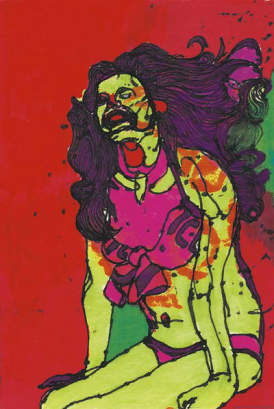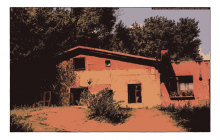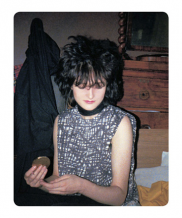| Umělec 2004/1 >> Pierre Daguin: Frank´s Wild Years(drawing section) - Home Gallery, 17 December – 30 January 2004 | Просмотр всех номеров | ||||||||||||
|
|||||||||||||
Pierre Daguin: Frank´s Wild Years(drawing section) - Home Gallery, 17 December – 30 January 2004Umělec 2004/101.01.2004 Louis Armand | review | en cs |
|||||||||||||
|
For Pierre Daguin’s return show in Prague at Home Gallery last December, entitled The Frank’s Wild Years: Drawing Section, Daguin exhibited a series of faux-naif renderings of images culled from pornographic magazines. Unlike Daguin’s previous work, these renderings take the form of line drawings, ink sketches, paintings and stylised outlines coloured-in with felt-tip markers like the images in a child’s picture book. The effect ranges from echoes of Egon Schiele, early Picasso and Hans Bellmer, to the lo-fi punk aesthetics of Sonic Youth album covers. Daguin’s use of colour is at once lush and toxic, vibrantly contrasted and indeterminate. Surfaces are colour-saturated or sparse, expressionistic or linear, or both. Figures are highlighted or placed under erasure, some having been entirely blacked out. The effect produced is that the more “explicit” the image, the less “pornographic” it becomes — its mimetic quality dissolving into composition, the eye foundering upon the self-exposed quality of a highly “posed” technics.
Daguin’s purpose here, we may speculate, has been to render the armature of pictorial desire not in terms of the imaginary but of the image itself as a form of structural outcome — the technics of drawing, of composition, of colouration. The technics onto which desire grafts itself in the operations of “pornographic” seeing, constitutes a blind — the unseeable beyond the illusion of an interminable optical unveiling. What Daguin affects is an index of traces and tracings from which the imaginary recedes and the fact of the unseeable begins to encroach upon the eye in the uncanny, disturbing manner of an “optical unconscious.” Combining the graphically explicit and the innocuous, Daguin’s work poses the question of “art or pornography?” In doing so, it affects a critique of the common structures that operate within an increasingly “visual” culture. In this way, Daguin’s work also acts to chronicle how images of commodified desire, in its supposedly crudest or basest aspects, remain subject to cultural recuperation — but also vice versa. And while Daguin’s drawings in this exhibition cannot be said to imitate or represent pornographic images as such, they nevertheless raise the problem of whether or not pornography operates as a way of producing art, or if art provides a means and indeed a condition for making pornography. If Duchamp drew attention to the role of the museum in sanctifying base objects (Richard Mutt’s urinal is usually cited in this argument), then Daguin draws our attention to how the sanctified (or permissive, and thus “sanitised”?) art object becomes pornography once we view the museum, or the contemporary art gallery, as a species of peep-show. Or, to put it another way, Daguin’s installation suggests that the sanctity and quite often morbidity of the museum space is itself an illustration of the age-old saying: post coitum tristis. Notably, Daguin’s show at HOME coincided with the gallery’s first anniversary — a year which has seen shows of IRWIN, Art Cubicle, Electrobot and several broadly conceived group shows representing the latest developments in local, regional, and international contemporary art in all its contours of unevenness. Of all of the exhibitions at HOME, however, Daguin’s represents the most cohesive and structurally coherent so far. Daguin’s small format “drawings,” mounted uniformly behind glass and arranged lineally to form a continuous horizon line around the large open gallery space, creates an ambience which is at once minimalist in its geometric conception, and expansive in the way it opens out the visual field of the gallery itself. As a venue for seeing — or an architecture of pure pornography — the gallery’s “white cube” functions both as a viewing “cubicle” and as an expanded field in which the mechanics of seeing become starkly evident. The installation’s physical arrangement invited the viewer to stand back, to become centred within the gallery space in order to take in the panoramic effect of Daguin’s horizon-like schema, at the same time as the individual works functioned to draw the eye into the “pornographic” image. This effect represents a crucial paradox in Daguin’s art and the calculated means by which he has chosen to present it: to view the whole, the viewer must remain centred in space, and therefore on the periphery of the image; to approach the image, the viewer moves centrifugally, recentring the eye within the “pornographic” field of the image that nevertheless lies at its periphery. That the image represents what must escape totalisation within a whole (the classic genre of pornography, which both lures and fragments the desire to see “the whole”) is one of the points Daguin’s work insists upon when considered in terms of its seriality and within the context of “pornography” as such. Daguin makes use of the fact that pornography explicitly poses a genitalised centricity — an effect not unlike the Renaissance technic of a perspective vanishing point, unconsciously structuring the viewer’s gaze and luring the eye towards an imaginary centre (the very structural nexus of “seeing” which, as a rule, remains beyond visual apprehension). While the eye “searches to see more,” the object of this optical desire is delayed or deferred, interminably, in a serial horizon effect of recession — precisely the effect Daguin simulates within the physical space of the gallery. Indeed, this brings us to another key aspect of Daguin’s installation: the way in which the pure opticality of the pornographic image plays against the physicality of the viewer situated in space. Not only is the act of “seeing” rendered as a de-centring of the viewer, constantly removed (as it were) from one image to the next according to the quasi-pornographic logic of the modern art gallery, but it is also “critiqued” in the way in which the “pornographic” images provoke an effect of synaesthesia. That is to say, pornographic “seeing” is not only conditioned by the removal of its object, within the visual field, but also by the desire to simulate a body, a physical object, out of the mechanics of this seeing-not-seeing itself. The viewing subject is reduced to an eye, whose desire-to-see simulates an encounter with the physical body whose fragments these images somehow represent. As Daguin knows, the optical illusionism of so-called pornography reveals a spectacle in which the apparently omniscient “eye” of the viewer is in fact the mirror-image of someone being fucked. Among Daguin’s previous activities in Prague was his participation in the First Biannual Festival Foto Praha-Kolín, 1998, entitled “Body and Photography” and curated by Martina Pachmanová. Of those also included in the 1st Foto Biannual were Alena Kotzmannová, Veronika Bromová, Pavel Mára, Tono Stano and Václav Stratil. Daguin’s contribution, “Around the World,” which was also exhibited at the Belgian Cultural Institute on Karlovo Náměsti, comprised a large series of juxtaposed photographic images: half self-portraits of Daguin himself, adopting various holiday, travel or expeditionary personae; the other half being images that may well have been culled from soft porn and fashion magazines (in fact they pictures of retro-models by Carlo Mollin, a famous architect and designer, which were discovered after his death). Each diptych was entitled by means of a geographic locality, e.g. “New York (USA),” “Lisbon (Portugal),” “Lima (Peru)” — imitating the form of a pictorial/sexual travelogue. The effect of many of the juxtapositions in “Around the World” is often hilarious, with Daguin’s comic self-presentations set against often lush or gorgeous female nudes. The found-object quality of the nudes operates both to suggest the pictorial accumulation of postcard impressions of exotic destinations (sexualised in the manner of tourism brochures hyping travel-consumerist desire), and to heighten the paradoxically trashy and collectable nature of these symbols of transient (and vicarious) “pleasure.” Like Huysman’s cult of simulationism, Daguin’s stereo tableaux play upon the idea that man’s relationship with the world of experience always takes place through a matrix of desire and representation, whose virtuality leads it to be situated anywhere and nowhere, but whose lineaments are no less “real” for that, since it is the imaginary itself which stands as its object.
01.01.2004
Рекомендуемые статьи
|
|||||||||||||
|
04.02.2020 10:17
Letošní 50. ročník Art Basel přilákal celkem 93 000 návštěvníků a sběratelů z 80 zemí světa. 290 prémiových galerií představilo umělecká díla od počátku 20. století až po současnost. Hlavní sektor přehlídky, tradičně v prvním patře výstavního prostoru, představil 232 předních galerií z celého světa nabízející umění nejvyšší kvality. Veletrh ukázal vzestupný trend prodeje prostřednictvím galerií jak soukromým sbírkám, tak i institucím. Kromě hlavního veletrhu stály za návštěvu i ty přidružené: Volta, Liste a Photo Basel, k tomu doprovodné programy a výstavy v místních institucích, které kvalitou daleko přesahují hranice města tj. Kunsthalle Basel, Kunstmuseum, Tinguely muzeum nebo Fondation Beyeler.
|

































 New book by I.M.Jirous in English at our online bookshop.
New book by I.M.Jirous in English at our online bookshop.
Комментарии
Статья не была прокомментированаДобавить новый комментарий